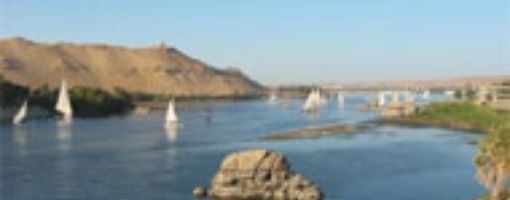THE NILE

The Nile winds its way 6,500 kilometers from its origins in theGreat African lakes to the Mediterranean. Its sources were unknown until the19th century. Today they have been identified in the Nyawarongo River, atributary of another river which enters LakeVictoria.
The Nile flows northwards across the immense savannah with its woodsand marshes before gathering in to itself from the left the waters of the BahrGhazzal (the Gazelle River) originating in the Darfour and Congo regions, andfrom the right the waters of the Sobat, the Blue Nile (or Bahr el Azrak) and theAtbarah from the high plateaus of Abyssinia. It then runs up against thelimestone barrier of the Sahara and its progress is interrupted by thecataracts as it flows slowly towards the Mediterranean without receiving thewaters of any other tributary. Egypt proper is simply that northern part of thisgreat valley which extends from the cataracts at Aswan to the sea. From Aswan tothe ruins of Thebes the valley narrows, being penned in between two chains ofrocky mountains, but between Thebes and Cairo it becomes considerably wideragain.
AtEl Manach the Nile divides into two: the eastern part constitutes the principalbranch. Shortly after the Nile leaves Cairo it loses sight of the mountainswhich up to then have followed its course. The Arabian and Libyan mountains getfurther and further apart and rise up respectively on the edge of the Red Seaand in the Mediterranean to the west of Alexandria. In the vast triangular plainof the Delta a multitude of canals link the Rashid or Rosetta branch to theDamiette or Domiatte branch.
Each year following the torrential rains which fall on the mountains ofAbyssinia and the region of the equatorial lakes, the Nile becomes more and moreswollen until finally it bursts its banks and in a few months fills up theentire valley. By the end of April the flooding has reached Khartoum, thecapital of the Sudan, and by the end of May or beginning of June it reachesEgypt proper via Nubia. Until October the valley remains covered with thebeneficial layer of mud laid down by the flood which only disappearscompletely at the beginning of December. As a result of this periodicflooding Egypt has a particularly rich flora and fauna. There are many types ofbig trees, numerous species of acacia and sycamore, forests of palm trees andmany aquatic plants including the papyrus and the lotus. The Nile and its lakesare swarming with fish. Most domestic animals have been known in Egypt since theearliest times. On the other hand many species of wild animal have disappearedwith the passing of the centuries. Thus one no longer finds there either lionsor the large cats such as the leopard and the cheetah. The hippopotamus left theDelta towards the end of the 16th century and following the appearance ofsteam boats on the river it retreated beyond the cataracts as did the crocodile.If it were not for the flooding of the Nile the great Egyptian valley wouldbe a sterile desert. This is why Herodotus's statement that « Egypt is a gift ofthe Nile » continues to be as true today as when he saidit.
PRIMITIVE IRRIGATION
The system of irrigation in Egypt is primitive and most of the work hasto be done manually. The major problem is that of raising the water from theriver to the level of the banks. The land slopes away from the river, doubtlessas a result of the annual allusion, so that there is nothing easier, once thewater has been raised to the level of the bank, than to send it down thechannels right to the edge of the river in the period when its waters havewithdrawn to its natural bed. The water is generally 4 or 5 meters below thelevel of the land and soon it will be even lower. To overcome this difference inlevels use is made of the creaking « sakhyeh », a water wheel usually operatedby asses or oxen. Alternatively water can be drawn from the Nile by meansof the « shadoof », a simple leather bucket which is dipped in the river, filledwith water and then raised by means of a counterweight, consisting of otherbuckets, at various levels, until the water finally reaches the field. Ithas been calculated that this device can lift about 50 liters of water a minute,and pictures in Egyptian tombs prove that it has been in use on the banks of theNile for more than three thousand years. No one has ever thought of improving itin spite of all the innovations and conquests oftechnology.
THE EGYPTIAN CLIMATE
Your Rating:
Overall rating: 0.000
Totally voted: 0
Comments
Weather in:
Exchange Rates
-
IMF loan expected next month
Apr 22, 2013, rating: 3.000, 3 votes Egypt may secure an International Monetary Fund loan agreement in about amonth, state news agency MENA reported, quoting "informed" sources ...
Egypt may secure an International Monetary Fund loan agreement in about amonth, state news agency MENA reported, quoting "informed" sources ...
-
Egypt received 11 million tourists in 2012 and aims to boost that number to 14 million in 2013.
Jan 22, 2013, rating: 3.000, 2 votes
Egypt received 11 million tourists in 2012 and aims to boost that number to 14 million in 2013.
-
Egypt limits travelers leaving country to US$10,000 in cash
Dec 26, 2012, rating: 3.250, 4 votes Egypt has banned travelers from carrying more than US$10,000 in foreigncurrency cash in or out of the country ...
Egypt has banned travelers from carrying more than US$10,000 in foreigncurrency cash in or out of the country ...
-
National Coalition on Climate Change for Egypt is born
Nov 30, 2012, rating: 5.000, 1 votes The global COP18 conference on climate change opens in Doha Monday.About 17,000 participants from all over the world ...
The global COP18 conference on climate change opens in Doha Monday.About 17,000 participants from all over the world ...
-
Judgment for sexual harassment
Nov 14, 2012, rating: 3.600, 5 votes A man was sentenced to two years in prison and fined LE 2,000 for sexually harassing a woman, an ...
A man was sentenced to two years in prison and fined LE 2,000 for sexually harassing a woman, an ...
-
Scientists are enthusiastic about hydrogen's green applications
Nov 13, 2012, rating: 4.000, 3 votes
As fossil fuel reserves decrease, many countries are turning to hydrogen as one of the main sources of alternative energy ...








